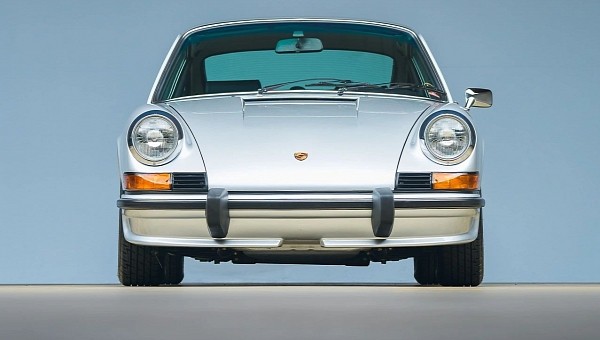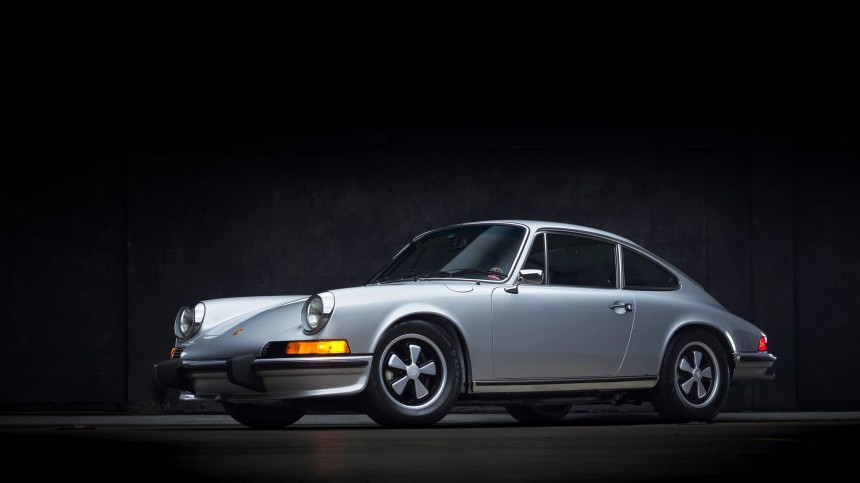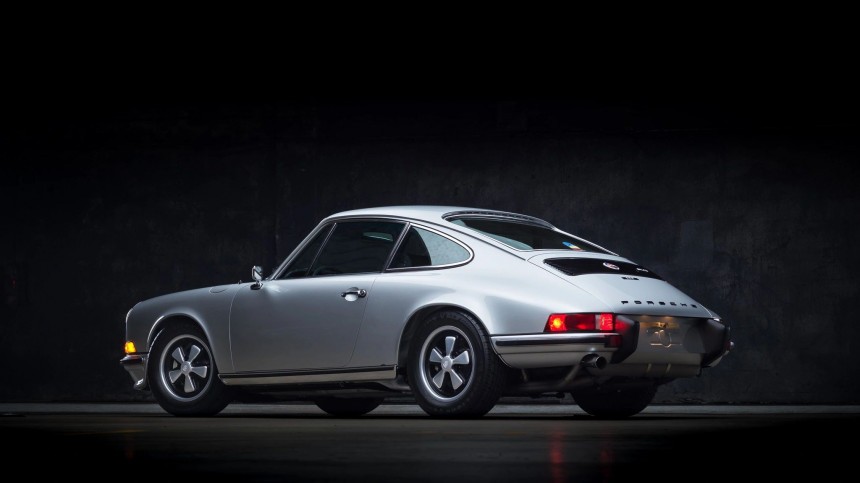The commercial success of the 356 encouraged Porsche to develop a larger, more comfortable, better handling, and more powerful replacement for the Stuttgart-based automaker’s first production model. The F-body 911 rolled out in 1964 with the O series, which came with 2.0-liter powerplants. Multiple improvements later, Germany’s best-known sports car manufacturer introduced the 2.4-liter E series in 1971.
Sold for the 1972 model year, the largest-displacement 911 yet came standard with steel wheels for the entry-level T, cookie-cutter alloys for the mid-range E, and Fuchs alloy wheels for the S. The performance-oriented variant also flaunted a couple of anti-roll bars as standard equipment, plus twin oil coolers, with the second cooler located in the right front fender.
In terms of chassis technology, the biggest departure from the 2.2-liter D series is the longer wheelbase. Porsche extended it by 3 millimeters to relocate the rear suspension mounting points for slightly better ride quality, as prospective customers expected from the company’s flagship model. The rear-engined sports car flaunts MacPherson struts and single lower wishbones up front, while the rear is taken care of by semi-trailing arms.
Another big difference over the previous iteration of the Neunelfer is the design of the semi-trailing arms, which can be removed to be serviced or replaced without the mammoth chore of dropping the six-pot boxer. Koni dampers were standard on the S, giving the S the edge over the T and E.
From a visual standpoint, you can tell a 1972 model year 911 apart from any other air-cooled 911 by looking for the oil filler door on the right rear fender. The fuel filler door, meanwhile, is located on the right front fender. Design alterations further include the slightly larger driver-side mirror, black for the engine lid’s grille, gunmetal for the model script, and a front spoiler that was standard on the S and optional on the two lesser siblings.
Tipping the scales at 1,050 kilograms (2,315 pounds) in the lightest configuration, the E series came out in 1971, the year Porsche approved the 928 that should have replaced the 911. The water-cooled GT with a front-mounted V8 flopped hard, but looking at the glass half full, it would have been even sadder had it actually replaced the car that still defines Porsche.
Available in fixed-head coupe and targa-top body styles, the E series leveled up to a beefier transmission dubbed Type 915. Although it weighs more than the 901 before it, the 915 can take more torque. The lower-powered T came with a four-speed gearbox, whereas the E and S boasted a five-speed gearbox. Porsche still offered the Sportomatic, a semi-automatic transmission that rocks a vacuum-operated clutch and a torque converter.
Increasing the stroke from 66 to 70.4 millimeters resulted in 2,341 cubic centimeters, which is why the E-series and subsequent F-series engine are sometimes referred to as 2.3-liter units. The 84-millimeter bore is shared with the 2,195-cc engine of the D- and C-series Neunelfer. Shorter connecting rods are featured, along with new camshafts and piston crowns, a forged crankshaft, a stiffened crankcase, and improved porting.
Two Zenith carburetors were standard for the T version, which cranked out 128 horsepower. Bosch-supplied mechanical fuel injection was employed for the 162-horsepower E and 188-horsepower S. In certain markets, such as the United States, the entry-level T came with mechanical fuel injection due to emission regulations. In this configuration, the 911 T is rated at 138 hp.
U.S.-spec vehicles also came with inertia reel seat belts. Optional extras varied from sensible things like air conditioning, fog lights, and leather upholstery to an electric sunroof, a long-range fuel tank, and a limited-slip differential. E-series 911 production came to a grinding halt in July 1971. Approximately 13,000 units were built, of which the T Coupe and T Targa were the most popular of the lot, with 4,894 and 3,344 units to their names.
The last hurrah of the F-body 911 is the appropriately-named F series. Porsche relocated the oil filler due to many peeps – both owners and gas station attendants - who mistook it for the fuel filler. You can also tell 1973 models apart from 1972s by the black-finished horn grilles. What’s more, 1973 was the first model year of the right-hand-drive Porsche 911 Targa.
Over in the United States, the entry-level T adopted Bosch K-Jetronic mechanical fuel injection, advertised there as the Bosch Continuous Injection System. The 1973 Porsche 911 T was the very first application of K-Jetronic, and the final application was the 1994 Porsche 911 Turbo 3.6.
1973s intended for the U.S. also stand out by means of bumper overriders, which polarize opinion with their design. Approximately 13,000 units of the F-series 911 were produced through July 1973, and once again, with a feeling, the T Coupe and T Targa sold best. That year, the German automaker introduced the G-body 911. Subsequent iterations ran through 1989, the year the 964 launched, with major upgrades both inside and out.
In terms of chassis technology, the biggest departure from the 2.2-liter D series is the longer wheelbase. Porsche extended it by 3 millimeters to relocate the rear suspension mounting points for slightly better ride quality, as prospective customers expected from the company’s flagship model. The rear-engined sports car flaunts MacPherson struts and single lower wishbones up front, while the rear is taken care of by semi-trailing arms.
Another big difference over the previous iteration of the Neunelfer is the design of the semi-trailing arms, which can be removed to be serviced or replaced without the mammoth chore of dropping the six-pot boxer. Koni dampers were standard on the S, giving the S the edge over the T and E.
From a visual standpoint, you can tell a 1972 model year 911 apart from any other air-cooled 911 by looking for the oil filler door on the right rear fender. The fuel filler door, meanwhile, is located on the right front fender. Design alterations further include the slightly larger driver-side mirror, black for the engine lid’s grille, gunmetal for the model script, and a front spoiler that was standard on the S and optional on the two lesser siblings.
Available in fixed-head coupe and targa-top body styles, the E series leveled up to a beefier transmission dubbed Type 915. Although it weighs more than the 901 before it, the 915 can take more torque. The lower-powered T came with a four-speed gearbox, whereas the E and S boasted a five-speed gearbox. Porsche still offered the Sportomatic, a semi-automatic transmission that rocks a vacuum-operated clutch and a torque converter.
Increasing the stroke from 66 to 70.4 millimeters resulted in 2,341 cubic centimeters, which is why the E-series and subsequent F-series engine are sometimes referred to as 2.3-liter units. The 84-millimeter bore is shared with the 2,195-cc engine of the D- and C-series Neunelfer. Shorter connecting rods are featured, along with new camshafts and piston crowns, a forged crankshaft, a stiffened crankcase, and improved porting.
Two Zenith carburetors were standard for the T version, which cranked out 128 horsepower. Bosch-supplied mechanical fuel injection was employed for the 162-horsepower E and 188-horsepower S. In certain markets, such as the United States, the entry-level T came with mechanical fuel injection due to emission regulations. In this configuration, the 911 T is rated at 138 hp.
The last hurrah of the F-body 911 is the appropriately-named F series. Porsche relocated the oil filler due to many peeps – both owners and gas station attendants - who mistook it for the fuel filler. You can also tell 1973 models apart from 1972s by the black-finished horn grilles. What’s more, 1973 was the first model year of the right-hand-drive Porsche 911 Targa.
Over in the United States, the entry-level T adopted Bosch K-Jetronic mechanical fuel injection, advertised there as the Bosch Continuous Injection System. The 1973 Porsche 911 T was the very first application of K-Jetronic, and the final application was the 1994 Porsche 911 Turbo 3.6.
1973s intended for the U.S. also stand out by means of bumper overriders, which polarize opinion with their design. Approximately 13,000 units of the F-series 911 were produced through July 1973, and once again, with a feeling, the T Coupe and T Targa sold best. That year, the German automaker introduced the G-body 911. Subsequent iterations ran through 1989, the year the 964 launched, with major upgrades both inside and out.
















































































